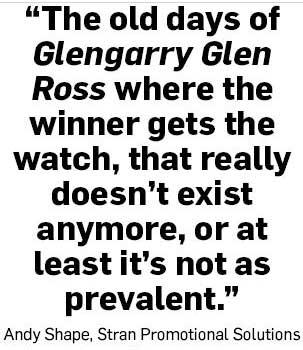September 13, 2016
Capitalize on Incentive Programs
This year, businesses will invest about $77 billion in non-cash rewards in an effort to praise, acknowledge and otherwise motivate their employees, customers and corporate partners. Call them incentives, spiffs, motivational tactics, promotional ploys or just good old-fashion marketing and management. But it’s all being done in an effort to make workplace improvements, according to a recent study by the Incentive Research Foundation (IRF), based in St. Louis.

That’s a huge opportunity for promotional product distributors looking to capitalize on a marketplace experiencing steady, meaningful growth, with 40% of companies planning to slightly or significantly increase incentive budgets this year, says Melissa Van Dyke, president of the IRF.
In recent years, in fact, Van Dyke and other experts say, incentive programs have not only grown, but shifted notably to embrace the interests and workplace needs of increasingly influential factors, including millennials and technology. That provides a rich sales opportunity for distributors targeting incentive program planners.
Here, we highlight some of the biggest changes to date in incentive program development and execution, as well as who is best for distributors to target when making an incentive sales pitch and which products are the most popular today.
Not Your Father’s Incentive Program
More than anything, one of the biggest changes to incentive programs has been their expansion in recent years to include not just sales incentives or employee performance programs, but efforts to increase safety, staff attendance, customer engagement, vendor relations and other growth and improvement opportunities across the board.
“The old days of Glengarry Glen Ross where the winner gets the watch, that really doesn’t exist anymore, or at least it’s not as prevalent,” says Andy Shape, president of Stran Promotional Solutions (asi/337725), a distributor based in Quincy, MA.
Rather than promote fierce competition, today’s most successful businesses are trying to do just the opposite by building camaraderie, Shape adds. Cohesiveness, experts say, is seen as the key to corporate growth and movement, with fierce internal competition being seen as more corrosive if taken to extremes.
More to the point, employee rewards are focused not just in performance-based categories these days. Companies are recognizing that not only do people need to be appreciated system wide, but that how, when and why they are incentivized is as important as the rewards and motivating tools they receive. The faster and more frequently managers can recognize and reward staff, they contend, the more likely they are to generate intrinsic motivation amongst employees.
To that end, one of the biggest changes to come along in recent years has been the need to reward and recognize in real time. Thanks to mobile technology, that’s an increasingly likely option for program managers, says Autumn Manning, CEO of Austin, TX-based employee engagement software provider YouEarnedIt. Today’s employees are often motivated by a sense of mission, purpose and personal recognition, Manning says. To leverage that experience further, Manning adds, programs such as YouEarnedIt allow employees to provide live feedback via internal “social recognition” sites where compliments and kudos can be posted in real time for all to see.
Notice a coworker going above and beyond for a customer? A shout-out can be sent from one colleague to the other via corporate social media, that others can read as well. Employees receive points for each recognition, with the ability to earn enough points toward an eventual merchandise reward.
In that way, merchandise is being used to nurture and support inherent motivation that younger workers bring to the workplace themselves. Peer-to-peer sharing does wonders to build employee self-esteem, and subsequently productivity, says Wes Higbee, president of Full City Tech Company, a New York-based business consultancy. Moreover, that kind of approach boosts creativity and risk taking, Higbee and others insist.
Speed Matters

Fostering that internal drive and motivation takes constant reinforcement, however. And, rewards (in the form of high-ticket items and traditional promotional products), coupled with social recognition, can help reinforce behavior-based incentive programs.
So can speed of delivery, which is often another key factor in today’s incentive programs, says Steve Damerow, CEO of Incentive Solutions in Atlanta. With three generations of employees in the workforce today, Damerow says, delivering rewards faster, and implementing recognition programs in real-time, particularly through mobile technology, has been crucial to motivating workers within generations X and Y.
“The average person looks at their smartphone 150 times a day,” Damerow says. Today’s most effective incentive programs leverage that fact. And companies like Incentive Solutions aim to meet that need by creating software for mobile technology in which recipients can view reward catalogs online, shop for items on-the-go and enjoy immediate pickup of a product through partners, such as Best Buy or Sears, Damerow says.
Certainly real-time rewards have gained increasing traction over the past decade, Van Dyke says. That’s in large part a result of market fluctuations and their effect on business health and the danger of demoralized workers. After the 2009 economic downturn, companies were forced to figure out ways to motivate workers who were asked to do more for less pay – not only within daily work hours, but in training, branding, wellness and innovation outside of their daily workload. This atmosphere quickly led to “job stacking and burnout,” Van Dyke says.
Within that movement came a push for greater employee engagement, she adds, and companies began exploring how to use incentives across a broader spectrum with “the growth of incentives being used to promote corporate values.” And to inspire staff to become greater corporate advocates, companies began trying to reward them in kind by giving workers greater flexibility in not only how they might choose to be motivated, but what product rewards and experiences they prefer as well.
What are today’s employees interested in being motivated with? Top product categories include electronics, luggage, jewelry, watches, apparel and golf items, according to the Incentive Research Foundation. But companies are aware that experiences such as a day off to volunteer within the community can be equally as rewarding. The key, Van Dyke and others say, is to offer a range of rewards – from merchandise and gift cards, to travel and other experiences – and to do it in real-time. That way, a company is not only giving public recognition to individuals, but allowing each worker to cherry-pick his most desired reward.
Vast Range of Products & Contacts
And with choice comes an opportunity for companies that have traditionally sold promo products and are looking to branch out into new sectors. Do you have your finger on the pulse of every product category ranging from bags and electronics to sports equipment and tools? Then you have the product knowledge to suggest items that can help to motivate your clients’ employees.
For distributors trying to tap the incentive marketplace, knowing who to contact at various companies can be tricky. Gone are the days when sales managers handled all incentives for a sales team.
These days corporate contacts can include human resource executives, safety managers, sales directors and plant managers, among others. It’s important to remember that incentives can be peer-to-peer as much as top-down from management to staff, say experts. What’s more, it’s important to recognize that companies are more likely to use multiple motivators or tasks at once, says Vip Sandhir, CEO and founder of Chicago-based HighGround, a firm focusing on cloud-based incentive software programs.
In addition, he says, incentives are doled out more frequently – daily, weekly and monthly, not just yearly – in an effort to reinforce motivation among staff and create a more intrinsic sense of inspiration among workers. Also, businesses are stepping away from tenure and service awards given out after a set number of years working for a company. With service awards, what’s expected tends to be perceived as “an entitlement, versus truly a reward,” Sandhir says, losing value along the way.
Today’s most effective incentive programs, he says, don’t just involve a product reward for years served, but products along with verbal recognition – in person and online in real-time – as well as spot rewards for unexpected workplace performances and moments of excellence, whether noticed by peers or executives. More to the point, many companies, rather than rewarding job performance, increased sales or other results are choosing to reward desired behaviors instead, Higbee says. “If you only reward on results, people won’t take legitimate risks,” Higbee says, “and will only act under certainty. That’s a recipe for a lack of innovation.”

For some distributors and suppliers, a more dynamic incentive marketplace has meant becoming more fluid in how their rewards can be delivered to clients and end-users. National Gift Card (asi/73011), a supplier in Crystal Lake, IL, for example, has spent more than a decade expanding its offerings and enhancing its deliverability by growing from a 4,000-square-foot office 12 years ago to its current 52,000-square-foot facility that warehouses, prints and delivers “hundreds of millions of dollars” in gift card sales each year.
Added to that in recent years has been the option to deliver rewards digitally as well, says Eric Thiegs, the company’s senior vice president. Popular gift card brands include Wal-Mart, Amazon, Target, Home Depot and Starbucks. The key to many of the 300 cards available via National Gift Card, Thiegs says, is the ease with which they can be incorporated into both real-time and face-to-face reward programs that require flexibility and speed in today’s more fast-paced incentive marketplace.
Being agile is key to distributor success in today’s incentive marketplace, says Thiegs. For example, investing in on-site card printers has allowed National Gift Card to customize inventory of cards on a moment’s notice and drop ship them to distributor clients or end-users directly.
Despite today’s ever-fluid marketplace, there’s still a place for more traditional incentives as well, says Danny Friedman, vice president of distributor firm Added Incentives (asi/106725), based in Northbrook, IL. Plenty of companies, he says, are still ordering promotional products, executing established incentive plans and handing out rewards in person a few times a year. The difference in today’s marketplace, he says, is that some companies carrying out more traditional programs are also incorporating elements such as online stores so that some employees can peruse online catalogs and select their own rewards more quickly than in years past.
In many of those programs, Friedman says, employers are using “staple” product categories to motivate staff, including polo shirts, fleece pullovers, jackets, hats, cooler bags and drinkware.
It’s among Gen Y employees that those same companies are starting to rethink reward products, adding more tech items, such as Bluetooth speakers, headphones, chargers and other technology accessories.
Regardless of the incentive program, personalization of rewards is gaining in popularity, says Stran’s Shape, whose company runs a series of online stores for corporate incentive programs. Like many of today’s incentives, Shape says, clients with corporate stores are looking for versatility and flexibility, eager to change up incentive programs and products as business goals and needs change.
In that way, personalization is playing a key role, Shape adds, by allowing clients to individualize reward products not just with corporate logos, but employee or department names as well. Products, he says, might include a worker’s name, home town, division or something that’s more than just a product with a corporate logo on it. Say Shape and others, it’s as much about connecting employees to a company’s brand and motivating them to care about their role in the firm’s success, as it is about recognizing individual efforts.